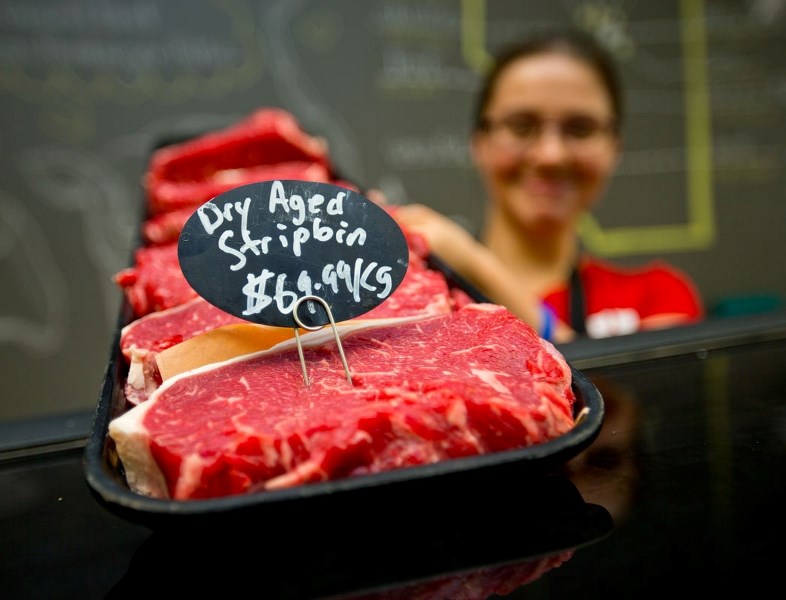Have you noticed your grocery bill continuing to rise, month after month? It’s not your imagination – prices for produce, meat and more are up across the country. And here in cattle country, beef is of particular note, where world demand, dry weather and a weak Canadian dollar are contributing to high cattle prices.
According to data released this week by Statistics Canada, dry conditions in Alberta and Saskatchewan have hurt the growth of grasses for cattle feed, forcing farmers to manage smaller cattle herds, buy feed or dip into winter-stock grains. That has translated into soaring beef prices in stores, with ground beef up 18 per cent from a year ago, and sirloin up 23 per cent, to about $24 per kilogram.
Even with the price hikes, D’Arcy’s Meat Market in St. Albert is doing a brisk business, as those who generally buy beef at the grocery store look to the butcher shops for quality cuts for their dollar.
“We’ve seen a substantial increase in sales, even though beef prices are high – we’re pretty much the same price for meats as the grocery store,” said D’Arcy’s owner Kyle Iseke. “Beef sales account for 40 per cent of all our business. We’re Albertans, so beef is just part of our heritage – it’s a staple for us, and sales are skyrocketing.”
Iseke said the increasing beef prices are a matter of supply and demand, with high world demand and local drought causing price spikes and a continued march upward in costs.
“But prices are stagnant for poultry, pork and bison. I haven’t raised my chicken prices in three years,” he said.
Iseke said beef producers and suppliers dictate price, but consumers can still find ways to save a bit on their beef bill, whether by choosing more economical cuts such as ground beef, pot roast and flank steak, or buying in bulk.
“It’s cheaper to buy freezer packages or half a cow. We get inquiries online and in-store all the time. Tenderloin and rib-eye is always going to be a more expensive choice, but there are alternatives,” he said.
According to the Food Institute at the University of Guelph, the slumping loonie means food prices across the board are expected to rise this year – up five to seven percent for vegetables, and three to five percent for fruits and nuts, meat, seafood and fish. Dairy and grain prices are expected to remain stagnant.
Basics like food and shelter already eat up a sizeable chunk of the household budget, whether it’s for one person or a large family. And while coupons and flyer specials can only go so far, there are many saving strategies and ways to stretch the food budget.
According to Everythingzoomer.com, that starts with properly packaging and storing food to prevent spoilage or freezer burn. Wrap meat and freezer-bound goods in heavy plastic, foil or freezer paper, said the website, and remove excess air or repackage bulk foods to prevent them from going stale.
Do-it-yourself is another cost-saving idea – buy a whole chicken and take it apart yourself, instead of buying pricier boneless, skinless chicken breasts. And use as much of the food as possible – chopping up broccoli stems and cauliflower leaves for stir fry, or stale bread for croutons or bread pudding.
A report from the Value Chain Management Centre in Ontario shows that Canadians throw away $27 billion worth of edible food each year, with 51 per cent coming from Canadian homes. The report said consumers tend to feed the fridge – over-purchasing of on-sale or bulk items as part of the problem, along with best-by dates, expectations of larger portion sizes and the plethora of restaurant and take-out meals that are part of our lives too.
To reduce food waste, try to buy perishable items throughout the week rather than in bulk, get smarter about food storage and use fruits and vegetables as fully as possible, said the report.
“Watermelon rinds can be used in a stir fry and overripe fruits and veggies can go into baking, a smoothie or soup stock,” said registered dietitian Cara Rosenbloom.
And, of course, with the boom in urban agriculture, there’s always the idea of growing your own vegetables and herbs in a backyard garden. Nothing beats a home-grown tomato or carrot.




